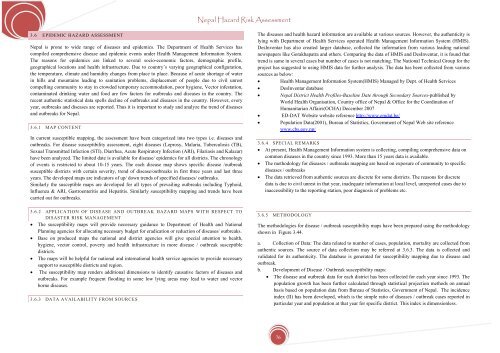Nepal Hazard Risk Assessment - Asia-Pacific Gateway for Disaster ...
Nepal Hazard Risk Assessment - Asia-Pacific Gateway for Disaster ...
Nepal Hazard Risk Assessment - Asia-Pacific Gateway for Disaster ...
Create successful ePaper yourself
Turn your PDF publications into a flip-book with our unique Google optimized e-Paper software.
<strong>Nepal</strong> <strong>Hazard</strong> <strong>Risk</strong> <strong>Assessment</strong><br />
3.6 EPIDEMIC HAZARD ASSESSMENT<br />
<strong>Nepal</strong> is prone to wide range of diseases and epidemics. The Department of Health Services has<br />
compiled comprehensive disease and epidemic events under Health Management In<strong>for</strong>mation System.<br />
The reasons <strong>for</strong> epidemics are linked to several socio-economic factors, demographic profile,<br />
geographical locations and health infrastructure. Due to country’s varying geographical configuration,<br />
the temperature, climate and humidity changes from place to place. Because of acute shortage of water<br />
in hills and mountains leading to sanitation problems, displacement of people due to civil unrest<br />
compelling community to stay in crowded temporary accommodation, poor hygiene, Vector infestation,<br />
contaminated drinking water and food are few factors <strong>for</strong> outbreaks and diseases in the country. The<br />
recent authentic statistical data spells decline of outbreaks and diseases in the country. However, every<br />
year, outbreaks and diseases are reported. Thus it is important to study and analyze the trend of diseases<br />
and outbreaks <strong>for</strong> <strong>Nepal</strong>.<br />
3.6.1 MAP CONTENT<br />
In current susceptible mapping, the assessment have been categorized into two types i.e. diseases and<br />
outbreaks. For disease susceptibility assessment, eight diseases (Leprosy, Malaria, Tuberculosis (TB),<br />
Sexual Transmitted Infection (STI), Diarrhea, Acute Respiratory Infection (ARI), Filariasis and Kalazar)<br />
have been analyzed. The limited date is available <strong>for</strong> disease/ epidemics <strong>for</strong> all districts. The chronology<br />
of events is restricted to about 10-15 years. The each disease map shows specific disease /outbreak<br />
susceptible districts with certain severity, trend of disease/outbreaks in first three years and last three<br />
years. The developed maps are indicators of up/ down trends of specified diseases/ outbreaks.<br />
Similarly the susceptible maps are developed <strong>for</strong> all types of prevailing outbreaks including Typhoid,<br />
Influenza & ARI, Gastroenteritis and Hepatitis. Similarly susceptibility mapping and trends have been<br />
carried out <strong>for</strong> outbreaks.<br />
The diseases and health hazard in<strong>for</strong>mation are available at various sources. However, the authenticity is<br />
lying with Department of Health Services operated Health Management In<strong>for</strong>mation System (HMIS).<br />
DesInventar has also created larger database, collected the in<strong>for</strong>mation from various leading national<br />
newspapers like Gorakhapatra and others. Comparing the data of HMIS and DesInventar, it is found that<br />
trend is same in several cases but number of cases is not matching. The National Technical Group <strong>for</strong> the<br />
project has suggested to using HMIS data <strong>for</strong> further analysis. The data has been collected from various<br />
sources as below:<br />
• Health Management In<strong>for</strong>mation System(HMIS) Managed by Dept. of Health Services<br />
• DesInventar database<br />
• <strong>Nepal</strong> District Health Profiles-Baseline Date through Secondary Sources-published by<br />
World Health Organisation, Country office of <strong>Nepal</strong> & Office <strong>for</strong> the Coordination of<br />
Humanitarian Affairs(OCHA) December 2007<br />
• ED-DAT Website website reference http://www.emdat.be/<br />
• Population Data(2001), Bureau of Statistics, Government of <strong>Nepal</strong> Web site reference<br />
www.cbs.gov.np/<br />
3.6.4 SPECIAL REMARKS<br />
• At present, Health Management In<strong>for</strong>mation system is collecting, compiling comprehensive data on<br />
common diseases in the country since 1993. More than 15 years data is available.<br />
• The methodology <strong>for</strong> diseases / outbreaks mapping are based on exposure of community to specific<br />
diseases / outbreaks<br />
• The data retrieved from authentic sources are discrete <strong>for</strong> some districts. The reasons <strong>for</strong> discrete<br />
data is due to civil unrest in that year, inadequate in<strong>for</strong>mation at local level, unreported cases due to<br />
inaccessibility to the reporting station, poor diagnosis of problems etc.<br />
3.6.2 APPLICATION OF DISEASE AND OUTBREAK HAZARD MAPS WITH RESPECT TO<br />
DISASTER RISK MANAGEMENT<br />
• The susceptibility maps will provide necessary guidance to Department of Health and National<br />
Planning agencies <strong>for</strong> allocating necessary budget <strong>for</strong> eradication or reduction of diseases/ outbreaks.<br />
• Base on produced maps the national and district agencies will give special attention to health,<br />
hygiene, vector control, poverty and health infrastructure in more disease / outbreak susceptible<br />
districts.<br />
• The maps will be helpful <strong>for</strong> national and international health service agencies to provide necessary<br />
support to susceptible districts and region.<br />
• The susceptibility map renders additional dimensions to identify causative factors of diseases and<br />
outbreaks. For example frequent flooding in some low lying areas may lead to water and vector<br />
borne diseases.<br />
3.6.3 DATA AVAILABILITY FROM SOURCES<br />
3.6.5 METHODOLOGY<br />
The methodologies <strong>for</strong> disease / outbreak susceptibility maps have been prepared using the methodology<br />
shown in Figure 3.44.<br />
a. Collection of Data: The data related to number of cases, population, mortality are collected from<br />
authentic sources. The source of data collection may be referred at 3.6.3. The data is collected and<br />
validated <strong>for</strong> its authenticity. The database is generated <strong>for</strong> susceptibility mapping due to disease and<br />
outbreak.<br />
b. Development of Disease / Outbreak susceptibility maps:<br />
• The disease and outbreak data <strong>for</strong> each district has been collected <strong>for</strong> each year since 1993. The<br />
population growth has been further calculated through statistical projection methods on annual<br />
basis based on population data from Bureau of Statistics, Government of <strong>Nepal</strong>. The incidence<br />
index (II) has been developed, which is the simple ratio of diseases / outbreak cases reported in<br />
particular year and population at that year <strong>for</strong> specific district. This index is dimensionless.<br />
76
















